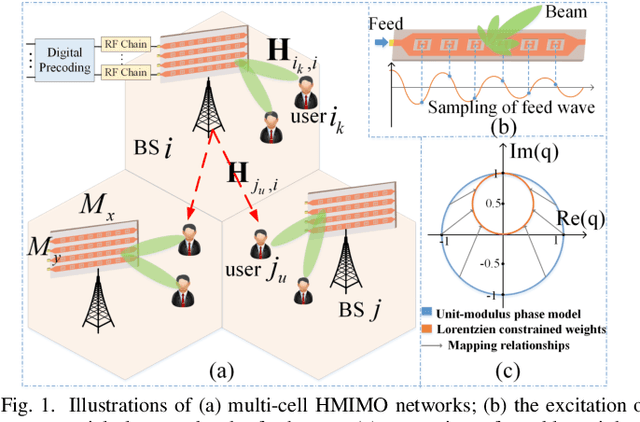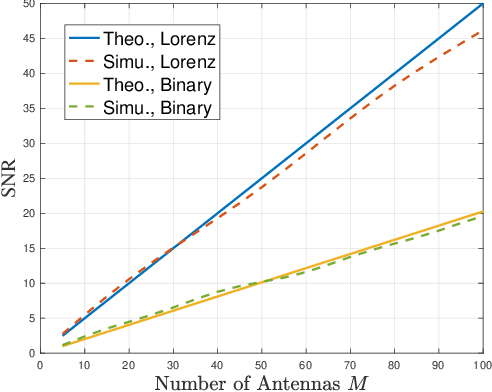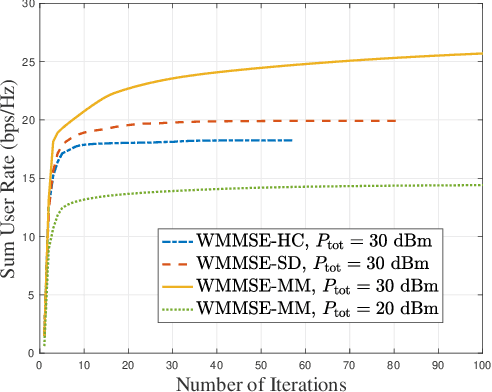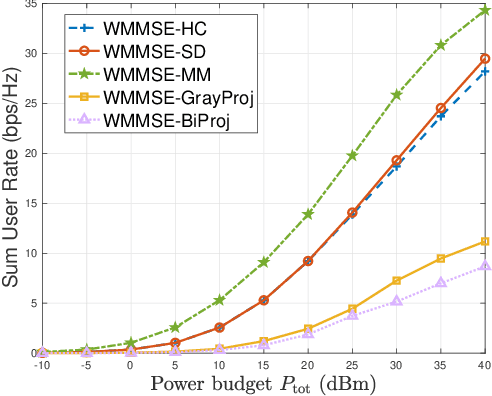Shuangyang Li
Hybrid Iterative Detection for OTFS: Interplay between Local L-MMSE and Global Message Passing
Dec 16, 2025Abstract:Orthogonal time frequency space (OTFS) modulation has emerged as a robust solution for high-mobility wireless communications. However, conventional detection algorithms, such as linear equalizers and message passing (MP) methods, either suffer from noise enhancement or fail under complex doubly-selective channels, especially in the presence of fractional delay and Doppler shifts. In this paper, we propose a hybrid low-complexity iterative detection framework that combines linear minimum mean square error (L-MMSE) estimation with MP-based probabilistic inference. The key idea is to apply a new delay-Doppler (DD) commutation precoder (DDCP) to the DD domain signal vector, such that the resulting effective channel matrix exhibits a structured form with several locally dense blocks that are sparsely inter-connected. This precoding structure enables a hybrid iterative detection strategy, where a low-dimensional L-MMSE estimation is applied to the dense blocks, while MP is utilized to exploit the sparse inter-block connections. Furthermore, we provide a detailed complexity analysis, which shows that the proposed scheme incurs lower computational cost compared to the full-size L-MMSE detection. The simulation results of convergence performance confirm that the proposed hybrid MP detection achieves fast and reliable convergence with controlled complexity. In terms of error performance, simulation results demonstrate that our scheme achieves significantly better bit error rate (BER) under various channel conditions. Particularly in multipath scenarios, the BER performance of the proposed method closely approaches the matched filter bound (MFB), indicating its near-optimal error performance.
On Discrete Ambiguity Functions of Random Communication Waveforms
Dec 09, 2025Abstract:This paper provides a fundamental characterization of the discrete ambiguity functions (AFs) of random communication waveforms under arbitrary orthonormal modulation with random constellation symbols, which serve as a key metric for evaluating the delay-Doppler sensing performance in future ISAC applications. A unified analytical framework is developed for two types of AFs, namely the discrete periodic AF (DP-AF) and the fast-slow time AF (FST-AF), where the latter may be seen as a small-Doppler approximation of the DP-AF. By analyzing the expectation of squared AFs, we derive exact closed-form expressions for both the expected sidelobe level (ESL) and the expected integrated sidelobe level (EISL) under the DP-AF and FST-AF formulations. For the DP-AF, we prove that the normalized EISL is identical for all orthogonal waveforms. To gain structural insights, we introduce a matrix representation based on the finite Weyl-Heisenberg (WH) group, where each delay-Doppler shift corresponds to a WH operator acting on the ISAC signal. This WH-group viewpoint yields sharp geometric constraints on the lowest sidelobes: The minimum ESL can only occur along a one-dimensional cut or over a set of widely dispersed delay-Doppler bins. Consequently, no waveform can attain the minimum ESL over any compact two-dimensional region, leading to a no-optimality (no-go) result under the DP-AF framework. For the FST-AF, the closed-form ESL and EISL expressions reveal a constellation-dependent regime governed by its kurtosis: The OFDM modulation achieves the minimum ESL for sub-Gaussian constellations, whereas the OTFS waveform becomes optimal for super-Gaussian constellations. Finally, four representative waveforms, namely, SC, OFDM, OTFS, and AFDM, are examined under both frameworks, and all theoretical results are verified through numerical examples.
Near-Field Integrated Imaging and Communication in Distributed MIMO Networks
Aug 24, 2025Abstract:In this work, we propose a general framework for wireless imaging in distributed MIMO wideband communication systems, considering multi-view non-isotropic targets and near-field propagation effects. For indoor scenarios where the objective is to image small-scale objects with high resolution, we propose a range migration algorithm (RMA)-based scheme using three kinds of array architectures: the full array, boundary array, and distributed boundary array. With non-isotropic near-field channels, we establish the Fourier transformation (FT)-based relationship between the imaging reflectivity and the distributed spatial-domain signals and discuss the corresponding theoretical properties. Next, for outdoor scenarios where the objective is to reconstruct the large-scale three-dimensional (3D) environment with coarse resolution, we propose a sparse Bayesian learning (SBL)-based algorithm to solve the multiple measurement vector (MMV) problem, which further addresses the non-isotropic reflectivity across different subcarriers. Numerical results demonstrate the effectiveness of the proposed algorithms in acquiring high-resolution small objects and accurately reconstructing large-scale environments.
Information-Theoretic Decentralized Secure Aggregation with Collusion Resilience
Aug 01, 2025Abstract:In decentralized federated learning (FL), multiple clients collaboratively learn a shared machine learning (ML) model by leveraging their privately held datasets distributed across the network, through interactive exchange of the intermediate model updates. To ensure data security, cryptographic techniques are commonly employed to protect model updates during aggregation. Despite growing interest in secure aggregation, existing works predominantly focus on protocol design and computational guarantees, with limited understanding of the fundamental information-theoretic limits of such systems. Moreover, optimal bounds on communication and key usage remain unknown in decentralized settings, where no central aggregator is available. Motivated by these gaps, we study the problem of decentralized secure aggregation (DSA) from an information-theoretic perspective. Specifically, we consider a network of $K$ fully-connected users, each holding a private input -- an abstraction of local training data -- who aim to securely compute the sum of all inputs. The security constraint requires that no user learns anything beyond the input sum, even when colluding with up to $T$ other users. We characterize the optimal rate region, which specifies the minimum achievable communication and secret key rates for DSA. In particular, we show that to securely compute one symbol of the desired input sum, each user must (i) transmit at least one symbol to others, (ii) hold at least one symbol of secret key, and (iii) all users must collectively hold no fewer than $K - 1$ independent key symbols. Our results establish the fundamental performance limits of DSA, providing insights for the design of provably secure and communication-efficient protocols in distributed learning systems.
Faster-than-Nyquist Signaling is Good for Single-Carrier ISAC: An Analytical Study
Jun 11, 2025Abstract:In this paper, we provide an analytical study of single-carrier faster-than-Nyquist (FTN) signaling for integrated sensing and communications (ISAC). Our derivations show that FTN is advantageous for ISAC, and reveal new insights that these advantages come from the fact that FTN signaling can effectively avoid the spectral aliasing due to the mismatch between the symbol rate and the bandwidth of the shaping pulse. Specifically, the communication spectral efficiency advantages of FTN signaling over time-invariant multipath channels are analytically shown, where both upper- and lower-bounds on the spectral efficiency are derived. We show that the gap between these two bounds corresponds to the potential signal-to-noise ratio (SNR) variation due to the presence of multipath delay and spectral aliasing, which diminishes as the symbol rate grows higher. Particularly, in the limiting case, this SNR variation disappears while the degree of freedom (DoF) of the system attain the maximum. Furthermore, the sensing advantages for FTN signals are verified in terms of the expected normalized squared ambiguity function. We show that FTN signals generally enjoy a more robust ranging performance. More importantly, we prove that FTN signaling can effectively avoid the undesired peaks in the considered ambiguity function along the Doppler dimension, thereby reducing the ambiguities in velocity estimation. All these conclusions are explicitly verified by numerical results.
Complexity-Scalable Near-Optimal Transceiver Design for Massive MIMO-BICM Systems
Apr 12, 2025Abstract:Future wireless networks are envisioned to employ multiple-input multiple-output (MIMO) transmissions with large array sizes, and therefore, the adoption of complexity-scalable transceiver becomes important. In this paper, we propose a novel complexity-scalable transceiver design for MIMO systems exploiting bit-interleaved coded modulation (termed MIMO-BICM systems). The proposed scheme leverages the channel bidiagonalization decomposition (CBD), based on which an optimization framework for the precoder and post-processor is developed for maximizing the mutual information (MI) with finite-alphabet inputs. Particularly, we unveil that the desired precoder and post-processor behave distinctively with respect to the operating signal-to-noise ratio (SNR), where the equivalent channel condition number (ECCN) serves as an effective indicator for the overall achievable rate performance. Specifically, at low SNRs, diagonal transmission with a large ECCN is advantageous, while at high SNRs, uniform subchannel gains with a small ECCN are preferred. This allows us to further propose a low-complexity generalized parallel CBD design (GP-CBD) based on Givens rotation according to a well-approximated closed-form performance metric on the achievable rates that takes into account the insights from the ECCN. Numerical results validate the superior performance of the proposed scheme in terms of achievable rate and bit error rate (BER), compared to state-of-the-art designs across various modulation and coding schemes (MCSs).
Sensing With Random Communication Signals
Apr 09, 2025



Abstract:Communication-centric Integrated Sensing and Communication (ISAC) has been recognized as a promising methodology to implement wireless sensing functionality over existing network architectures, due to its cost-effectiveness and backward compatibility to legacy cellular systems. However, the inherent randomness of the communication signal may incur huge fluctuations in sensing capabilities, leading to unfavorable detection and estimation performance. To address this issue, we elaborate on random ISAC signal processing methods in this article, aiming at improving the sensing performance without unduly deteriorating the communication functionality. Specifically, we commence by discussing the fundamentals of sensing with random communication signals, including the performance metrics and optimal ranging waveforms. Building on these concepts, we then present a general framework for random ISAC signal transmission, followed by an in-depth exploration of time-domain pulse shaping, frequency-domain constellation shaping, and spatial-domain precoding methods. We provide a comprehensive overview of each of these topics, including models, results, and design guidelines. Finally, we conclude this article by identifying several promising research directions for random ISAC signal transmission.
Group Sparsity Methods for Compressive Space-Frequency Channel Estimation and Spatial Equalization in Fluid Antenna System
Mar 03, 2025



Abstract:Fluid Antenna System (FAS) unlocks unprecedented flexibility in wireless channel optimization through spatial reconfigurability. However, its practical deployment is hindered by the coupled challenges posed by high-dimensional channel estimation and real-time position optimization. This paper bridges wireless propagation physics with compressed sensing theory to address these challenges through three aspects. First, we establish a group-sparse recovery framework for space-frequency characteristics (SFC) in FAS, formally characterizing leakage-induced sparsity degradation from limited aperture and bandwidth as a structured group-sparsity problem. By deriving dictionary-adapted group restricted isometry property (D-GRIP), we prove tight recovery bounds for a convex $\ell_1/\ell_2$-mixed norm optimization formulation that preserves leakage-aware sparsity patterns. Second, we develop a Descending Correlation Group Orthogonal Matching Pursuit (DC-GOMP) algorithm that systematically relaxes leakage constraints to reduce subcoherence. This approach enables robust FSC recovery with accelerated convergence and superior performance compared to conventional compressive sensing methods like OMP or GOMP. Third, we formulate spatial equalization (SE) as a mixed-integer linear programming (MILP) problem, ensuring optimality through the branch-and-bound method. To achieve real-time implementability while maintaining near-optimal performance, we complement this with a greedy algorithm. Simulation results demonstrate the proposed channel estimation algorithm effectively resolves energy misallocation and enables recovery of weak details, achieving superior recovery accuracy and convergence rate. The SE framework suppresses deep fading phenomena and reduces hardware deployment overhead while maintaining equivalent link reliability.
Holographic MIMO Multi-Cell Communications
Feb 23, 2025



Abstract:Metamaterial antennas are appealing for next-generation wireless networks due to their simplified hardware and much-reduced size, power, and cost. This paper investigates the holographic multiple-input multiple-output (HMIMO)-aided multi-cell systems with practical per-radio frequency (RF) chain power constraints. With multiple antennas at both base stations (BSs) and users, we design the baseband digital precoder and the tuning response of HMIMO metamaterial elements to maximize the weighted sum user rate. Specifically, under the framework of block coordinate descent (BCD) and weighted minimum mean square error (WMMSE) techniques, we derive the low-complexity closed-form solution for baseband precoder without requiring bisection search and matrix inversion. Then, for the design of HMIMO metamaterial elements under binary tuning constraints, we first propose a low-complexity suboptimal algorithm with closed-form solutions by exploiting the hidden convexity (HC) in the quadratic problem and then further propose an accelerated sphere decoding (SD)-based algorithm which yields global optimal solution in the iteration. For HMIMO metamaterial element design under the Lorentzian-constrained phase model, we propose a maximization-minorization (MM) algorithm with closed-form solutions at each iteration step. Furthermore, in a simplified multiple-input single-output (MISO) scenario, we derive the scaling law of downlink single-to-noise (SNR) for HMIMO with binary and Lorentzian tuning constraints and theoretically compare it with conventional fully digital/hybrid arrays. Simulation results demonstrate the effectiveness of our algorithms compared to benchmarks and the benefits of HMIMO compared to conventional arrays.
Affine Frequency Division Multiplexing: Extending OFDM for Scenario-Flexibility and Resilience
Feb 07, 2025



Abstract:Next-generation wireless networks are conceived to provide reliable and high-data-rate communication services for diverse scenarios, such as vehicle-to-vehicle, unmanned aerial vehicles, and satellite networks. The severe Doppler spreads in the underlying time-varying channels induce destructive inter-carrier interference (ICI) in the extensively adopted orthogonal frequency division multiplexing (OFDM) waveform, leading to severe performance degradation. This calls for a new air interface design that can accommodate the severe delay-Doppler spreads in highly dynamic channels while possessing sufficient flexibility to cater to various applications. This article provides a comprehensive overview of a promising chirp-based waveform named affine frequency division multiplexing (AFDM). It is featured with two tunable parameters and achieves optimal diversity order in doubly dispersive channels (DDC). We study the fundamental principle of AFDM, illustrating its intrinsic suitability for DDC. Based on that, several potential applications of AFDM are explored. Furthermore, the major challenges and the corresponding solutions of AFDM are presented, followed by several future research directions. Finally, we draw some instructive conclusions about AFDM, hoping to provide useful inspiration for its development.
 Add to Chrome
Add to Chrome Add to Firefox
Add to Firefox Add to Edge
Add to Edge